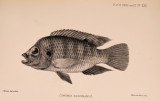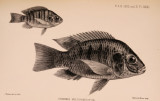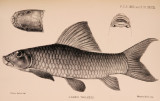| OCR Text |
Show 1902.] NEW IIARVEST-SPIDERS. 395 tlie first of which runs to the base of the 4tli leg ; the remaining four terga without spicules. Mandibles (text-fig. 79, A) with basal segment arcuate, thickly and strongly spicular above and internally, armed below, both externally and internally, with many long, strong, close-set spines; second segment stout, smooth except for some smallish spicules on the inner side at the base; the digits each with two larger spaced teeth and some smaller ones. Palpi with a sharp spine at the base of the maxillary process, studded with short, stifi bristles; tarsus long, much longer than tibia + patella, at least as long as femur. Legs with femora, and to a lesser degree the trochanters, studded with numerous conical tubercles or spicules; a few also on the patella of the 3rd and 4th legs. Measurements in mm.:-Total length 6-5 ; mandible about 9 ; palp 13 ; 1st leg 19, 2nd 29, 3rd 18, 4th 29 (approx.). IjOC. Natal (//. A . Spencer). This species is evidently nearly related to R. crassus Loman (Zool. Jahrb. xi. Syst. p. 520, pi. 31. figs. 7-9) from the Cape Colony (loc. ?), but apparently differs in the much smaller number of spicules in front of the ocular tubercle, the disposition of the spines on the ocular tubercle, the anterior and posterior rising at the same level and both on a level with the eye, and the absence of an angular projection on the base of the second segment of the mandibles. P h a l a n g iu m ( R h am p s in itu s ) te l ifr o n s , sp. n. (Text-fig. 79, B.) S . Colour yellowish brown, finely mottled with darker median dorsal band. Dorsal integument closely granular; abdomen with transverse segmental series of sharp tubercles. Ocular tubercle longer than high, more than its own diameter from the anterior border of the carapace (text-fig. 79, B), armed with two rows of 5-6 conical tubercles, the largest on the summit subequal to the diameter of the eye ; three denticles on the sides of the carapace between the ocular tubercle and the lateral impression, an oblique row external to them, frontal area furnished on each side with a cluster of about a dozen larger and smaller teeth; the middle of the anterior border with a longish, subcylindrical, horizontally directed spine. Mandibles a little longer than the body; basal segment studded above with numerous sharp tubercles, smooth at the proximal and distal extremities; armed below, externally and internally, with a partially double series of about seventeen or more longer and shorter, mostly curved short spines, decreasing in length towards the distal end of the segment and more or less clustered together at its proximal end ; second segment quite smooth except for a few small low tubercles on the upper inner angle, subcylindrical, a little wider at its widest than the second segment. Palpi simple, hairy; tarsus longer than femur, which is itself longer than |
































































































































































































































































































































